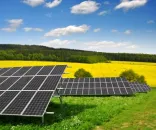
India's solar imports surged to 5.7GW
It's a whoppping 89% of the total solar module requirement.
India imported 5.7 GW or about 89% of its total solar module requirement in FY 2016-17. Value of these imports is estimated at USD 3 billion, equivalent to 2.8% of the country’s total merchandise trade deficit, according to Bridge to India.
An increasing reliance on imports in a growing and strategically important sector is creating various stress points and raises the risk of a knee-jerk policy reaction by the government which has, until now, been unable to effectively support domestic manufacturing.
China dominates global manufacturing and is trying to secure control on the technology upgradation roadmap for solar PV.
Here's more from Bridge to India:
Over reliance on a single country puts Indian solar sector at a risk of disruption in global supply chain and change in Chinese government policy.
The Indian government needs to consider long-term implications for the sector and draw up a well thought out plan for domestic manufacturing instead of introducing short-term support measures.
China has been pumping in billions of dollars in subsidies and other support measures to scale up solar PV manufacturing and dominate global market. The result is massive increase in manufacturing capacity from 23 GW in 2013 to over 70 GW today despite steep fall in prices.
It has also been strategically providing support for new technologies through its ‘Top Runner’ program to encourage the industry to migrate to higher-efficiency products and secure control on technology upgradation roadmap for solar PV.
India couldn’t match China’s financial commitment to the sector but provided some breathing room to local manufacturers through Domestic Content Requirement (DCR) and also toyed briefly with anti-dumping duties. However, such protectionist measures have not helped local manufacturing anywhere in the world and share of imports in India has continued to go up from 74% in 2014-15 to 89% in the last year. Notwithstanding various high profile announcements of new manufacturing capacity creation, the only notable player to do so in the last two years has been Adani, which has also deferred its vertical integration plans.
The Indian government’s overriding priority in the sector, so far, has been increasing generation capacity and lowering tariffs. That focus has hurt the prospects of domestic manufacturers who are unable to compete with Chinese imports and have now filed a new anti-dumping duty petition. With cost of solar power crashing to INR 2.44/kWh, there is a risk that the government may be tempted into a knee-jerk decision causing confusion in the market.
We have consistently argued that protectionism will not solve the problems of Indian manufacturers. But ever-increasing share of imports for solar modules is a concern when India plans to meet a significant share of its power requirement from solar and a huge majority of modules are imported from a single country. The entire sector is exposed to the risk of a potential disruption in global supply chain and/or change in international political, trade or economic environment. We have seen how changes related to Indonesian coal production have severely affected some Indian thermal IPPs introducing a series of litigation and regulatory uncertainty.
Given the multi-faceted implications for project developers, investors, DISCOMs and other stakeholders, we need a larger debate on the role of domestic manufacturing in the sector. And instead of considering short-term response to this issue, the Indian government should consider long-term implications for the sector and send a clear policy signal to reduce uncertainty for all stakeholders.













 Advertise
Advertise











